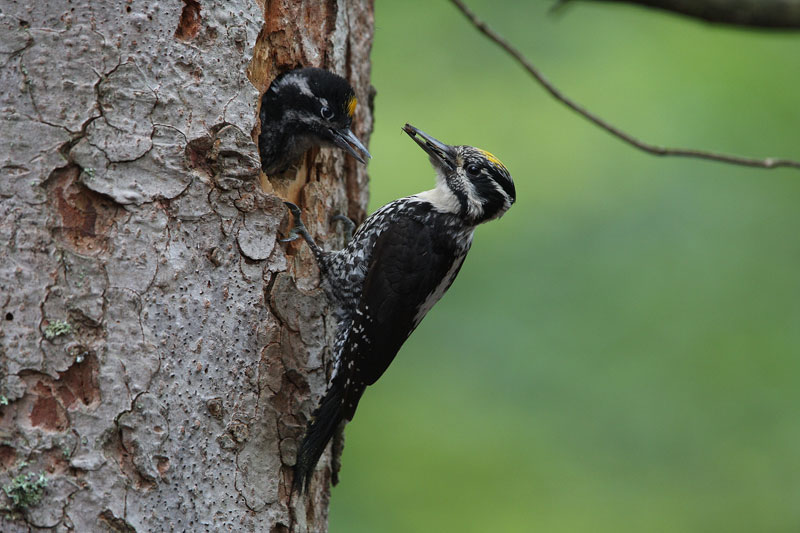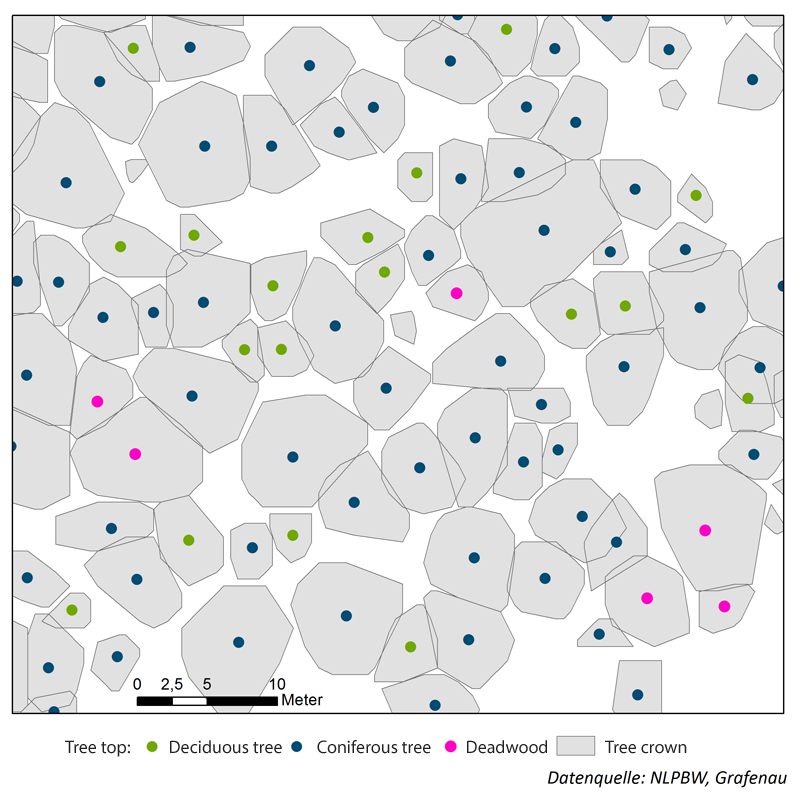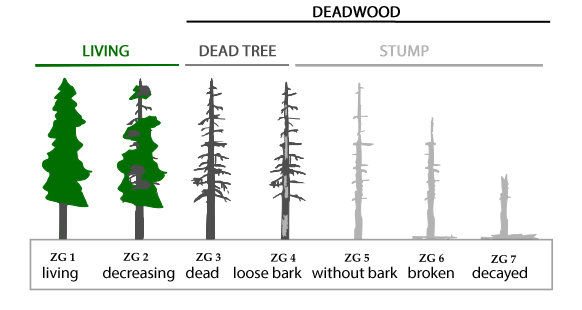Deadwood as a habitat

Fig. 1: Three-toed woodpecker(Picoides tridactylus)
Photo: Christof Moning
Deadwood is an important structural element in forests, on which 20 to 25 % of all forest species depend. Standing or lying, from newly dead to completely decomposed, deadwood provides a habitat for many species of animals, fungi and plants.
Different species of wood beetles colonise the standing or lying deadwood, depending on the decomposition stage of the wood. Woodpeckers like the rare three-toed woodpecker (Picoides tridactylus), whose diet consists mainly of bark beetles, look for their food there. The cavities they carve out for themselves are later also used by other cavity-dwellers such as dormice, forest birds and bats.
Deadwood is a key structural element for forest biodiversity. However, commercial forests often do not accumulate the required quantity and quality of deadwood to support highly specialised species with specific demands in terms of this resource.
How much deadwood is needed?
But how much deadwood do species like the three-toed woodpecker really need? For the evaluation of programmes promoting old trees and deadwood, and in order to find good compromise solutions in times of increased natural disturbances, this is a central question. One approach to answering this question is to analyse the requirements of deadwood-dependent species and to determine threshold values with regard to the quantity and quality of deadwood they require, above which these species have good conditions for reproduction, or which represent the optimum habitat for these species.
The three-toed woodpecker feeds mainly on bark beetles of the species Ips typographus (European eight-toothed spruce bark beetle or European spruce bark beetle), but also on other insects that colonise deadwood. It is thus dependent on an availability of dying and newly dead trees. The three-toed woodpecker is considered an umbrella species for other xylobiontic species that benefit from the protection of the three-toed woodpecker habitats. It is also considered to be a keystone species for cavity-nesting birds. For these reasons, and because of its rarity in Germany, the three-toed woodpecker is often selected as a target species for forest conservation programmes.

Fig. 2: Sample presentation of data derived from the remote sensing data for tree tops, crown areas and deciduous/coniferous/deadwood tree types.
Methodology: not all deadwood is the same
In order to analyse the habitat requirements of the three-toed woodpecker, the habitat features of areas with and without documented woodpecker occurrences were compared.
Laser scanning (LiDAR) and infrared aerial photographs were used in the study to obtain individual tree data for the entire area of the Bavarian Forest National Park. For extensive areas, they delivered information on breast height diameter (BHD), basal area (G), tree height (H) and timber volume (VOL). The use of the LiDAR technology made a precise survey of the forest and tree structures possible. By combining it with colour infrared aerial images, it was possible to distinguish between deciduous and coniferous trees and deadwood.
With the aim of analysing both the quantity and quality of the deadwood, standing deadwood was first divided into "dead trees" and "stumps". Based on tree height (H) and crown area (C), the classification was as follows:
- "Dead tree": deadwood with an average branch length of at least 2 m (C > 4 m²) and a tree height of more than 15 m (H ≥ 15 m);
- "Stump": deadwood with (C < 4 m²) or (C > 4 m² and H < 15 m).
This means that newly dead wood, which is particularly important for the three-toed woodpecker, can be distinguished from deadwood with a higher degree of decomposition.

Fig. 3: Assignment of the trees to classes: living stand and deadwood, subdivided into dead trees and stumps according to their stages of decomposition. The decreasing horizontal expansion of the tree crown in the decomposition process served as the basis for the classification using remote sensing data.
Results: Not too much deadwood, and living coniferous trees are also necessary
The availability and number of living, dying and newly dead spruce trees were essential for the habitat selection of the three-toed woodpecker. With eight or more dead trees per hectare, the probability of woodpecker occurrence was 75 to 80%. The mean crown area of the standing deadwood (both dead "trees" and "stumps") had a positive effect on the occurrence of the three-toed woodpecker, underlining the importance of dead trees with large crowns at relatively early stages of decomposition.
Interestingly, an upper threshold for deadwood occurrence was also found: if the number of standing dead trees exceeded 40 to 55 per hectare, the probability of an occurrence of the three-toed woodpecker dropped again. Something similar was observed by Scherzinger after bark beetle calamities in the Bavarian Forest National Park: after an initial considerable increase in the number of three-toed woodpecker territories immediately after the forest stands died, the population shrank again after just five years, when the European spruce bark beetle and other freshwood colonisers had left the trees again.
The results also underline how important the role of the living coniferous stand is in the habitat use of three-toed woodpeckers: There must not be too many, but nor must there be too few living trees in relation to deadwood. Similar statements are to be found in a study by Braunisch.
The study presented here provides target values for the promotion of the three-toed woodpecker as an integrated part of forest management.
Summary
- With a total of at least eight newly dead trees with large crowns (preferably spruce) per hectare, the probability of woodpecker occurrence increased to 75 to 80%.
- For this to happen, these values must be achieved over an area of at least 20 ha, or in an area with a radius of 100 to 250 m around the breeding tree.
- Leaving islands of deadwood at a minimum distance of 500 m from each other can be a compromise between promoting the three-toed woodpecker and preventing bark beetles.
The results also show how conservation management and species promotion can be supported by remote sensing methods.

